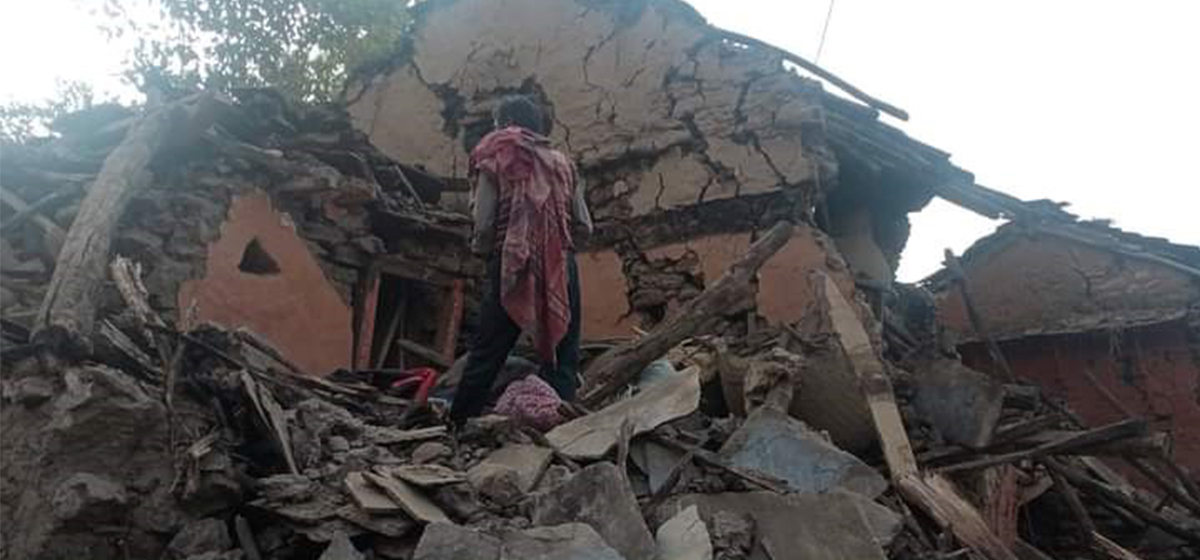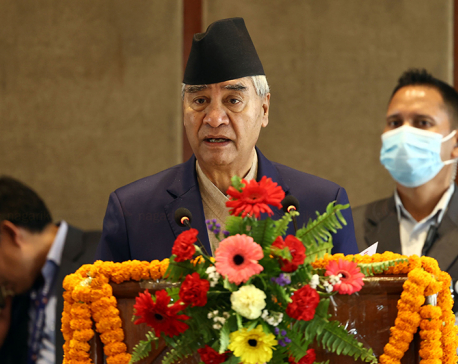
OR
Far West of Nepal at high seismic risk
Published On: January 29, 2023 03:30 PM NPT By: PUSHPA RAJ JOSHI

KAILALI, Jan 29: Last November 9, in the morning, an earthquake of 6.6 magnitude occurred, with its center around the Khaptad National Park. Due to the earthquake, six people died and seven were injured when the building of the East Chowki Rural Municipality of Doti collapsed.
Similarly, an earthquake of magnitude 5.9 occurred at 2:43 PM last Tuesday, with the epicenter around Maula village in Bajura. The earthquake destroyed some houses and one person died.
These incidents prove that in recent times western parts of Nepal, including the Far West Province, is at a high seismic risk. According to seismologist Bharat Prasad Koirala of the National Earthquake Monitoring & Research Center, there has been no earthquake in the western region of Nepal since the last 518 years. Stating that the energy to cause earthquakes has been stored under the ground of western Nepal for such a long time, he said, “Since 1505, there has not been a major earthquake in the mountainous region from Gorkha in Nepal to Dehradun in West India. So, a large amount of energy to cause earthquakes has been stored here.”
An earthquake of magnitude 7.6 occurred in Gorkha in 2072. Seismologists say that before and after that since 518 years, there has not been such a large earthquake in the western region of the country. He said that the mountain region from Nepal’s Gorkha to India’s Dehradun has accumulated great energy to cause earthquakes and that energy can only be released through earthquakes.
Stating that a large and massive earthquake may occur or may not occur for years, he said, “It is true that energy is stored. The means of earthquakes is to release the stored energy of large-scale earthquakes.”
He added, "The energy will be released gradually with the occurrence of small and large earthquakes. Therefore, it is necessary for the local governments, the provincial government and the federal government to carry out a public awareness program so that there is no huge financial loss in case of an earthquake in Western Nepal.”
Stating that the Indian plate and the Eurasian plate are colliding with each other under the ground of Nepal, he said, "The energy generated by the collision of the same plate is being accumulated."
Seismologists estimate that the same energy can affect from west of Gorkha to Dehradun in India. He confirmed that Nepal is at risk of earthquakes due to the fact that Nepal has about 2500 km long active ice chain from Afghanistan in the west to Myanmar (Burma) in the east and one third of the middle part 800 km from East Mechi to West Mahakali.
Seismologist Koirala said that the energy to cause a great earthquake (equal to 8 magnitude and more) is stored underground in the western region of Nepal and said that the only way to release all that stored energy is an earthquake. According to seismologists, 32 earthquakes of 5 Richter scale are equal to the power of an earthquake measuring 6 on the Richter Scale.
Similarly, the force of an earthquake measuring 7 on the Richter Scale is equal to that of 1000 earthquakes measuring 5 on the Richter Scale. An earthquake measuring 8 on the Richter Scale produces the same force as 1000 earthquakes measuring 6 on the Richter scale. Therefore, Koirala says that this area is always at high risk due to the accumulation of such a large seismic energy. Even though great earthquakes occur every hundred years, 8 to 10 small earthquakes occur daily in Nepal. "Earthquakes smaller than 3.5 on the Richter Scale cannot be felt by people," he added.
He said that many people know only when there is a medium and large earthquake. He says that the western part of Nepal is at a high risk of earthquakes because small earthquakes are occurring on a daily basis. In Kailali, old towns and settlements are more vulnerable to earthquakes. “Old houses and settlements that are not earthquake-resistant are more at risk,” he said.
You May Like This

KMC’s support to earthquake victims of Doti
KATHMANDU, Dec 19: The Kathmandu Metropolitan City (KMC) has provided financial support to the earthquake victims of Purbichauki Rural Municipality... Read More...

PM Deuba directs authorities to ensure immediate rescue and relief efforts in earthquake-hit areas
KATHMANDU, Nov 9: Prime Minister and President of Nepali Congress Sher Bahadur Deuba has instructed the relevant agencies to arrange... Read More...

People injured in earthquake undergoing treatment in Doti
DOTI, Nov 9: Five people who were seriously injured in the earthquake last night are undergoing treatment at Doti Hospital. Read More...




Just In
- Govt receives 1,658 proposals for startup loans; Minimum of 50 points required for eligibility
- Unified Socialist leader Sodari appointed Sudurpaschim CM
- One Nepali dies in UAE flood
- Madhesh Province CM Yadav expands cabinet
- 12-hour OPD service at Damauli Hospital from Thursday
- Lawmaker Dr Sharma provides Rs 2 million to children's hospital
- BFIs' lending to private sector increases by only 4.3 percent to Rs 5.087 trillion in first eight months of current FY
- NEPSE nosedives 19.56 points; daily turnover falls to Rs 2.09 billion















Leave A Comment